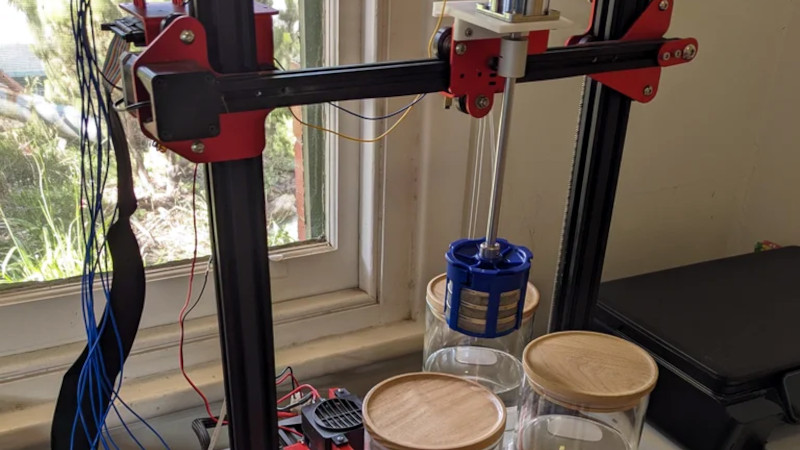The many delicate parts in a mechanical wristwatch present a tricky cleaning problem, one that for professionals there is a variety of machines to tackle. As you might expect, such specialty equipment doesn’t come cheap, so [daveburkeaus] came up with his own solution, automated using an older 3D printer.
The premise is straightforward enough: it’s a machine with a succession of stations for cleaning, rinsing, and drying, through which the watch is moved on a set cycle. The hot end and extruder is replaced with a motor and shaft, on the end of which is a basket in which the watch sits. The basket is a commercial part for simplicity of construction, though one could certainly fabricate their own if need be. The printer gets a controller upgrade and of course a motor controller, and with a software stack built upwards from the Klipper firmware seems ready to go. There is the small matter of the heater used for drying not keeping the firmware happy as a substitute for the heated bed it thinks it’s driving, but that is fixed by controlling it directly.
We’ve remarked before that superseded 3D printers are present in large numbers in our community, and particularly now a few years since that article was written we’re reaching the point at which many very capable machines are sitting idle. It’s thus particularly good to see a project that brings one of them out of retirement for a useful purpose.

















This is definitely a hack, I like it! Personally I wouldn’t “waste” an old 3D printer this way but that’s probably because washing watches has no value for me.
He might want to add another bearing along the shaft, the wobble will wear those out very, very quickly. A sturdy 3D printed extension would go a long way. Probably best to shorten the shaft to the minimum too.
On a quick glance it looks reversible, so I guess that printer is not wasted.
But I agree on the shaft, I don’t get why he left it so long.
I stand corrected, the printer has just changed function, for the time being at least. Amazing what those 3D printers can do! My 2D ink guzzler can only bleed ink and money.
Something tells me that if FDM printers were as ubiquitous as their 2D cousins they would be just as bad.
I feel like a member of the tin foil hat brigade when I type this. But, I’m sure 2D printers are intentionally bad.
Someone I knew long ago used to use benzine (it is carcinogenic) to clean mechanical watches and clocks.
Benzene hasn’t been used commercially in decades by anyone, how old was this person? Even the old timers now usually haven’t touched pure benzene.
I like this hack, but the critical part appears missing, which is the hard part- the ultrasonic transducers.
The cheapest machine offered with ultrasonic transducer is the Lititz Precision Products Matador 4000, which is 3.3k$. you can clean watches without ultrasonic, but the difference is night and day in the cleanliness. This would be a great option for those working on antique pieces though that can have plating damaged by ultrasonic if not careful.
What about just using off the shelf ultrasonic cleaners instead? Set up three of the small ones and modify them to be switched on just with a signal, rather than the button it probably uses, or just switch them all on, on a long timer.
Then just have the printer move the basket of parts into the ultrasonic cleaners.
That would probably be simpler and easier than trying to use ultrasonic transducers on their own.
Benzene != benzine.. Depending on where Truth lives, benzine could be naphtha, which is what I use as well.
I like this hack as well, but U/S is not needed at all really. I started off with u/s before I bought an old Elma cleaning machine. It can be handy when things are particularly crusty, but I don’t use mine much anymore. For normal service work, the biggest difference is from using a ammoniated solution, which leaves everything beautifully bright and clean (I use Elma 9:1).
On another note, I’ve been thinking about replacing the motor in my elma with a though-shaft stepper, so that I can have nicer forward-reverse and spinoff motion, instead of just simple forward. I bought a cheap stepper from China, but had a lot of trouble driving it. I’m also not sure how to introduce ‘slippage’ intentionally, so that the motor will never drive the basket with full force and wreck my hairspring etc :)
I use Zenith ammoniated solution, specifically Zenith Formula 67, and Zenith Drizebrite rinse, for my own work. I have an Elma S40H tank ultrasonic I use, full of water, with small glass jars suspended in that in a basket, with my solution in those glass jars, to clean when I need to.
This method can be used to effectively clean safely in a tank ultrasonic, but you need to be very careful not to leave things for very long in these as the large ultrasonic is much more aggressive. Antique watches can have plating stripped with ammoniated solutions if they are left in too long. Some of this I base off of what I learned in watchmaking school about a decade ago.
If you don’t have ultrasonic cleaning action, certain parts of the watch need extra care by hand before you clean, such as jewel oil sinks. Those should be scrubbed with sharpened sticks of pegwood, always ideally, even with ultrasonic. And please- The safest way to clean any watch with a hairspring in an ultrasonic, is to leave the balance & balance cock screwed to the mainplate in the jewels. This prevents mainly the hair spring from getting jacked up.
Last tip- it is best to clean by hand jewel holes and stones using pith and pegwood even after coming out of a cleaner. There is no cleaning solution that exists that doesn’t leave an almost imperceptible film on the surfaces. Usually this protects the brass, but it can affect how oil is held. Cleaning afterward the stones with pegwood, and treating with steric acid (epilomb solution) where needed will help oil stay where it needs to. Using a hair dryer to quickly dry the epilomb over watchmakers paper to wick away as fast as possible and keep moisture out helps a great deal.
The 3D printer could also be adapted to properly steep your tea.
This is a phenomenal coincidence. I just finished converting a broken Ender 3d (about £60 on ebay) into a watch cleaner, and mine is extremely similar. I started off buying the printer as a way to get the steppers and controller cheap, but realised that it already formed the base of a phenomenal cleaner. Wasn’t aware of any similar solutions. Existing cleaners seem to use rotary selectors for the jars. I didn’t design this one, but to answer some of the queries, it’s not a waste of a 3d printer because actual automatic watch cleaners cost >£4000. If you repair watches, then they’re extremely useful. The long shaft is because the jar needs to be tall enough to spin off excess fluid before moving to the next jar. 3d printer is an amazing base because it already has programmable heater and fan control for the dryer as well as stepper control for the axes. Simple case of writing g-code for it.